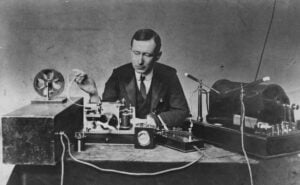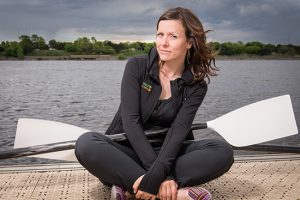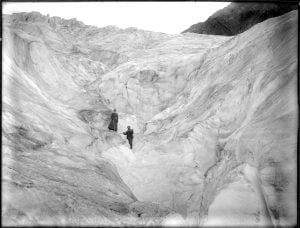
History
Ham radio and the world of amateur radio operators
A dive into the fascinating evolution of radio, starting from the first received message at Signal Hill, Newfoundland
- 2442 words
- 10 minutes
People & Culture

On a cold day in late April 1945, Louise de Kiriline Lawrence hiked four kilometres through dense forest to a bushy white spruce where Canada Jays had woven dry sticks between a fork of branches, creating a frame for the bowl they’d shaped from last year’s oak leaves, bits of wasp nest, and tent caterpillar cocoon. Inside the bowl, five eggs, beautifully white and spotted with olive brown, lay with their small ends neatly turned into the bottom of the well-insulated nest.
At the time, almost nothing was known about the species that is now Canada’s national bird. A gregarious creature in summer, in spring it is shy about raising its young, retreating into the boreal wilderness, just as Louise had retreated to her patch of forest on the Mattawa River after a hectic year as nurse-in-charge of the world-famous Dionne Quintuplets. When Louise told a scientist at the National Museum in Ottawa about the Canada Jay nest, he urged her to learn as much as she could about the birds’ nesting habits.
“Thus, armed with watch, mirror, and a blanket (how I wished I had thought of a groundsheet too that day because the best spot for observation happened to be all but in the little rivulet), I set out on my first nest-watching expedition with no previous experience but much enthusiasm.”
The clouds hung low, pushed swiftly by a wind from the northeast. The temperature hovered just below freezing. Louise set up a flat trap baited with suet and settled on a stump within sight of the nest, holding the blanket close and sitting perfectly still, hoping the jays would accept her as part of the landscape. She smeared a nearby stick with peanut butter. The jays flew in, swallowed the peanut butter with a soft xhrae and flew back to their eggs, ignoring the trap. Without the certainty of holding one in her hand, Louise couldn’t distinguish male from female, both dark grey above, lighter grey below, a distinctive white patch on the forehead and black at the back of the head. She assumed she was watching a mated pair.
“Uttering mellow notes, they stepped around the nest and over it, apparently undecided which one of them ought to sit down on it. In growing excitement both crouched and shivered their wings until finally one of them entered the nest and sat down on the eggs, carefully adjusting them under its brood spot. The other followed and sat down on top of the first bird, their bodies slightly cross-wise. The one covering the eggs, with only its head and tail showing, was embedded deeply under the long, fluffed feathers of the one on top.”

For an hour and a half, the birds sat on the eggs, stacked like a double duvet. Heavy snow began to fall, then the wind picked up and Louise left, afraid she wouldn’t be able to see to find her way home. She had sat by the nest for six hours.
The blizzard raged all the next day. In the afternoon, Louise waded back to her watching post. Snow was piling on the top bird so thickly that now and then it had to get up and shake the snow off, strutting around if trying to warm up. Louise lasted four hours.
On the fifth day, Louise arrived just before sunrise. The nest had been pillaged, all the eggs taken but one, which was still warm to the touch when she clambered up the tree to check. She searched the surrounding woods and finally found the parents, huddled in a white spruce, miewing and trembling their wings and opening their bills to one another. Then the birds flew off. Louise caught glimpses of them at long intervals, until they disappeared altogether.
After twenty-one hours of watching, Louise concluded that the winter-nesting Canada Jays keep their eggs warm by both parents incubating together, stacked on the nest — the first time such behaviour was observed. She sent her report to the National Museum, along with the carefully boxed nest containing the sole remaining egg, which was tested and found infertile. The nest and egg were added “to the collections of the nation.” Two years later, “Five Days with a Pair of Nesting Canada Jays” appeared in The Canadian Field-Naturalist, her first published study.
Louise’s initiation into nest-watching had taken her into almost-virgin ornithological territory, alive with controversy — was this a mated pair or “sisters” at the nest? — and rich with opportunities to make a contribution.
How could she resist?

“You should see us now running around the bush at the twitter of a strange bird, at the flutter of wings, book in hand to watch and decide what particular bird is nesting or flirting in our bushes and tree-tops,” Louise exclaimed in a letter to her mother. “It is amazing what a variety of birds there are now that we are beginning to discover them.”
Not content to simply name the birds, Louise wanted to know everything about how they lived. Taverner, with whom she developed an intense correspondence, suggested the only way to really know a bird was to hold it in the hand, and so she built a trap and taught herself to band birds.
For seventeen years — 1942 to 1959 — she operated the most northerly banding station in Ontario, live-trapping and slipping tiny aluminum bands onto the ankles of 2,628 individual birds representing fifty species. In order to catch them, she had to know what they ate, whether they were tree creepers or ground feeders, shy or curious, all of which determined which trap to use and how to bait it.
“There is a trick to every trade and the same goes for observation,” she wrote to Taverner. “To you, of course, all this is an old story of which you know all the chapters. To me it is just the very first paragraph in a fascinating fairy book which you opened before me.”
Over the next forty years, Louise set a record for counting birdsong that has never been broken — she followed a Red-eyed Vireo from dawn to dusk, counting its 22,197 songs. She wrote life histories of wilderness birds like the Yellow-bellied Sapsucker, whose lives until then were a mystery. She parsed the meaning of bird behaviours that scientists are only now proving to be true: that birdsong is nuanced language and hoarding by chickadees is not random but the stocking of a winter pantry that is emptied in precise order. Fifteen years before Rachel Carson’s Silent Spring, she charted the decline of thirteen species of songbirds in her forest — the Chestnut-sided, Mourning and Canada Warblers, dropped by 75 per cent over a decade — and experimentally linked that depopulation to the roadside spraying of toxic chemicals.
She published six books and almost a hundred articles about birds in scientific journals and popular magazines, pounding away at her typewriter in a log house isolated in the middle of the woods, remote from the privileged world of Swedish aristocracy she was born into and far from other scientists and scientific libraries. Far from anyone at all, yet for fifty years the top ornithologists on the continent beat a path to her door.
“I know of no occupation so fulfilling as that of becoming a watcher,” Louise wrote. “The observing self is pushed into the background and obliterated except for a cramped leg or an aching muscle imposed by enforced immobility…all senses are focused upon the amazing events that are constantly taking place.”
What Louise accomplished as a self-trained ornithologist was remarkable, but as she would be the first to tell you, hers could be the story of any number of amateurs — many of them women — scattered across Canada through the last century, standing for hours in forests, meadows, and swamps, lifting their binoculars to watch.

Are you passionate about Canadian geography?
You can support Canadian Geographic in 3 ways:

History
A dive into the fascinating evolution of radio, starting from the first received message at Signal Hill, Newfoundland

People & Culture
Whether diving in Antarctic waters, making scientific breakthroughs or summiting Everest, these remarkable women are making their mark on Canada and the world.

History
Mary Vaux’s groundbreaking 19th-century study of B.C.’s Illecillewaet Glacier created an invaluable record of the glacier’s recession

Wildlife
How one grassroots organization in Toronto makes our glass landscapes less deadly for birds.